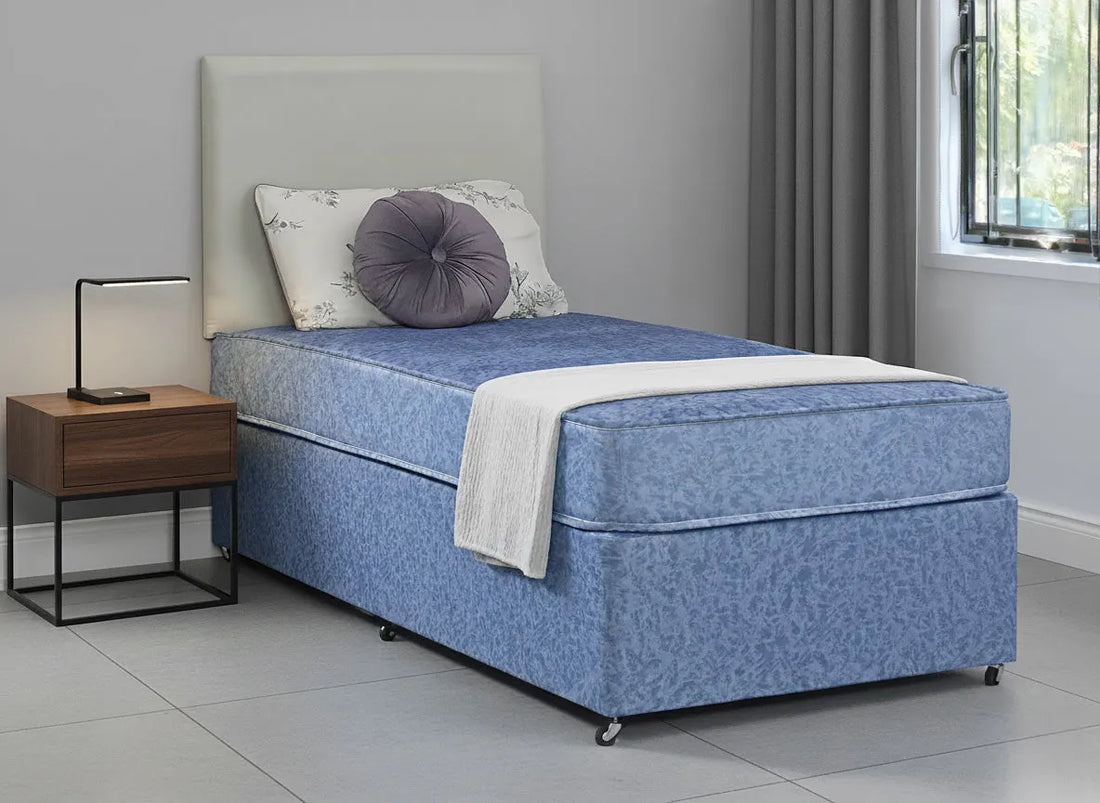Care homes need beds that protect residents and simplify staff work. Care contract divan beds deliver durability, hygiene, and safety features built for continuous use. This article explains why care contract divan beds matter for Keighley and UK care homes, and how to choose the right model for safety and comfort.
TL;DR / Key Takeaways
-
Care contract divan beds offer durability, hygiene, and safety features designed for long-term care use.
-
Waterproof surfaces, fire retardant bases, hoist clearance, and safety rails reduce risk and support staff.
-
Facilities often see fewer maintenance calls and lower lifetime costs compared with domestic beds.
-
Choosing the right bed helps meet CQC, fire safety, and infection control expectations.
-
Base prices start in the low hundreds, with configurations to match budgets and clinical needs.
What are care contract divan beds and why do care homes in the UK use them?
Care contract divan beds are robust beds made for care settings and continuous use. A care contract divan bed is a purpose-built bed system for care homes that combines a strong base, easy-clean finishes, and features for safe handling. Examples include waterproof finishes, fire retardant divan bases, hoist clearance, and optional adjustable bases and safety rails. Crown Contract Beds lists models with water-resistant fabrics and drawer storage suitable for care settings — see their care contract divan beds collection for specifics.
Safety benefits: how do they reduce risk for residents?
These beds lower falls, entrapment, and transfer risks through design and materials. Care contract beds use firm frames and controlled heights to limit fall risk. *Hoist clearance* helps safe transfers and reduces manual handling injuries for staff. Fire-retardant bases support statutory fire safety regimes. Waterproof and wipe-clean surfaces cut infection risks and speed up cleaning between uses.
Comfort and well-being: do they improve resident quality of life?
Better bases and mattress compatibility boost sleep and reduce pressure injury risk. These beds accept pressure-relief and orthopaedic mattresses that protect skin and comfort residents. Stable divan bases stop mattress migration and improve sleep. Adjustable profiling options help residents find comfortable positions and support independence while maintaining safety.
Durability, longevity, and total cost of ownership
Contract divan beds last longer and lower long-term costs compared with domestic beds. Professional contract beds typically last 7+ years in care use, while domestic beds often need replacement after 2–3 years. Fewer replacements reduce procurement time and costs. One provider reported up to a 76% reduction in bed-related maintenance calls after upgrading to contract beds, which lowers service overheads and downtime.
Practicality for facilities management and staff efficiency
These beds simplify cleaning, handling, and stock management for care teams. Waterproof, wipe-clean materials reduce cleaning time and help meet infection control protocols. Standardised sizes, hoist clearance, and drawer options make room planning and resident transfers quicker. Many UK suppliers keep models in stock to shorten lead times and support rollouts.
Design options, materials, and regulatory considerations
Pick features that match clinical, safety, and procurement needs. Look for waterproof fabrics, fire retardant bases, adjustable profiling, and safety rails. Materials should accept approved cleaning agents and meet CQC expectations for safety and infection control.
How to choose the right care contract divan bed: 5-step checklist
-
Define resident safety and infection control priorities.
-
Confirm hoist clearance and transfer requirements.
-
Assess durability, warranty terms, and service history.
-
Check material compatibility with cleaning agents.
-
Align budget, delivery lead times, and aftersales support.
Real-life use case: a Keighley care home’s experience
A Keighley facility upgraded to waterproof, hoist-clearance divan beds and saw practical gains. The home replaced domestic beds with Crown Contract Beds’ waterproof divan options fitted with safety rails. Outcomes included smoother transfers, fewer maintenance calls, quicker cleaning cycles, and better regulatory readiness. Staff reported easier handling and residents benefited from improved sleep and fewer skin issues.
Quick-reference comparison: contract divan bed vs domestic bed
|
Feature |
Contract Divan Bed |
Domestic Bed |
|
Lifespan |
7+ years |
2–3 years |
|
Safety |
Fire retardant, hoist clearance, rails |
Variable, often limited |
|
Hygiene |
Waterproof, wipe-clean |
Fabric prone to contamination |
|
Maintenance |
Fewer calls, warranty support |
More frequent repairs |
Key features to look for
-
Waterproof and wipe-clean surfaces
-
Fire retardant divan bases
-
Hoist clearance and safe transfer zones
-
Adjustable profiling options
-
Safety rails and anti-ligature designs where needed
Summary
Care contract divan beds provide measurable safety, hygiene, and cost benefits for Keighley and UK care homes. Choosing models with waterproof surfaces, fire-retardant bases, and hoist clearance protects residents and eases staff workload. For procurement or demonstrations, contact Crown Contract Beds to discuss specifications and quotes.
FAQ
What are care contract divan beds?
They are durable beds designed for ongoing care use with hygiene and safety features.
Do these beds reduce falls or injuries?
Yes. Proper height, hoist clearance, and solid frames lower transfer and fall risks.
Are they easy to clean and maintain?
Yes. Waterproof and wipe-clean materials simplify infection control routines.
How long do they typically last?
Typically 7+ years under normal care home use and maintenance.
Are waterproof options common and helpful?
Yes. They reduce contamination risk and make cleaning faster.
Can these beds support hoists?
Yes. Many models include hoist clearance and transfer-friendly designs.








